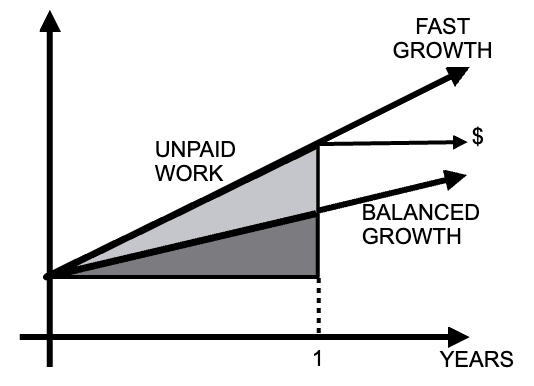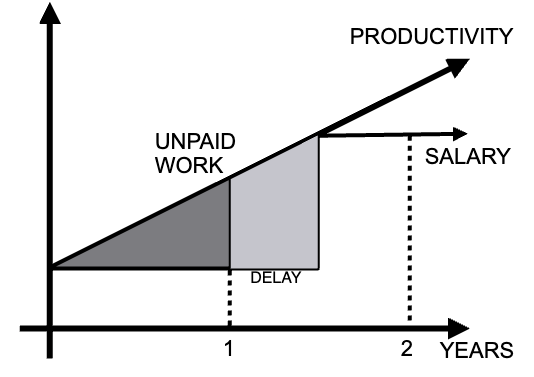WHITEPAPER – (link to PDF version)
Abstract
In today’s corporate environment, the traditional pathway to career advancement is paradoxically structured to systematically exploit personal development.
Employees are routinely required to “prove” their readiness for the next role by performing responsibilities beyond their current pay grade—a process that extracts uncompensated labor in the form of extra hours, increased stress, and higher levels of accountability.
Upon earning a promotion, there is no back-pay or retroactive recognition for the additional labor already performed. Instead, the cycle is reset, demanding even greater overperformance for any further advancement.
Ironically, those who reach a desired level and seek work-life balance [1] rather than continue escalating their contributions are often stigmatized as “lacking ambition,” perpetuating a culture of relentless, unpaid overwork.

1. Working Above Pay Grade: The Silent Expectation
In most organizations, promotions are not granted based on excellence within one’s current role, but rather based on demonstrated capacity to perform the next role [2].
Employees are:
- Expected to take on “stretch projects” beyond their defined job scope.
- Assumed to work longer hours without formal acknowledgment.
- Required to shoulder higher levels of decision-making responsibility.
Yet these demands come without immediate compensation or formal contractual change.
Result: Workers deliver future value today without being paid for it.
2. The Recognition Trap: No Retroactive Compensation
Upon eventual (and often delayed for as much as possible) promotion:
- The new salary is forward-looking.
- Past contributions beyond scope are not compensated retroactively.
- Additional hours, stress, and mental load carried during the “proving” phase are erased from official history.
Effectively: Employees are taxed retroactively for their hard work and loyalty.
3. The Infinite Promotion Hamster Wheel
After each promotion, the expectation resets:
- New performance thresholds are set.
- New “above-pay-grade” efforts are expected.
- The burden to work again beyond compensation reemerges.
Thus, promotion is not an end, but a new starting line, requiring unpaid labor to climb again.
4. The No-Growth Shaming Cycle
Employees who, after reaching a certain level, seek to maintain stable contributions aligned to their pay (also known as work-life balance) are often:
- Labeled “not growth-minded”
- Passed over for critical projects
- Pressured to “stretch” indefinitely
The Catch-22: Stability is treated as stagnation. The only “approved” path is endless escalation—requiring perpetual overwork for uncertain rewards.
5. The “Slow” Growth Shaming Cycle
Even employees who choose to “grow” but at a reasonable pace—are often stigmatized since a slower pace also implies a “lack of ambition.” However, a slower growth curve actually means less unpaid labor extracted between promotions.

When growth is aggressive:
- Employees take on increasing workloads rapidly.
- Larger amounts of unpaid “above-pay-grade” work accumulate before recognition.
- Productivity lost to the company without a pay raise increases substantially.
Thus, paradoxically, the faster you chase promotions, the more uncompensated labor you surrender. The system rewards the optics of growth while financially exploiting the most diligent and hard-working performers.
6. The Incentive to Delay Promotions
Companies are structurally incentivized to delay promotions for as long as possible:
- The longer an employee works “above their grade,” the more value is extracted without corresponding salary increases.
- By stretching the “proving” phase indefinitely, organizations gain free management, leadership, and innovation work at a discount.

Even if the employee eventually becomes frustrated and quits:
- The company retains the upgraded systems, knowledge, and efficiencies the employee built during their unpaid overperformance.
- Replacement workers can then be slotted into the newly improved structures, often at a lower cost.
Thus:
- Whether the employee stays or leaves, the company wins.
- The worker shoulders the full risk while the organization harvests the rewards.
This structural incentive creates an environment where genuine recognition is perpetually delayed, fostering burnout, resentment, and disillusionment among high performers.
7. Conclusion: The Human Cost of Corporate Greed
The current corporate advancement model systematically exploits personal growth by:
- Extracting free labor during the “proving” phase.
- Normalizing uncompensated overwork.
- Punishing stability and work-life balance.
Until organizations acknowledge this structural tax on personal growth, employees must navigate career growth with a clear-eyed understanding of the real, often hidden costs.
7.1. Recommendations
Individuals should set personal boundaries around free labor expectations, negotiate “development roles” with interim compensation when possible, and resist cultural pressures that shame sustainable career pacing.
Another way workers can protect themselves is project-based work.
It involves a fixed amount of work for a fixed amount of money. If the worker becomes more productive during the project, it will result in an earlier completion and payment.
True growth is not found in an endless chase for promotions. True growth is building sovereignty over your labor, time, and income.
References
[1] Work-life balance, Wikipedia, https://en.wikipedia.org/wiki/Work%E2%80%93life_balance
[2] Promotion (rank), Wikipedia, https://en.wikipedia.org/wiki/Promotion_(rank)

